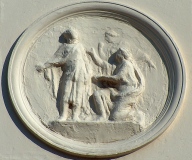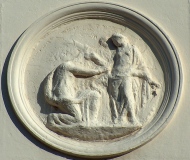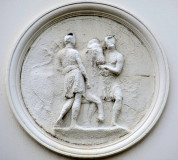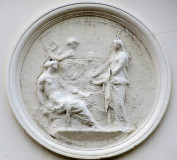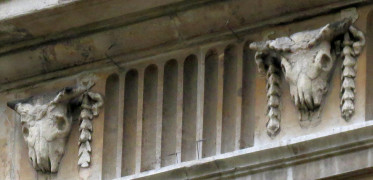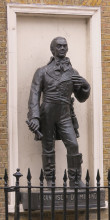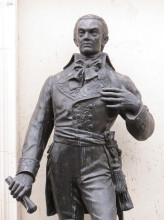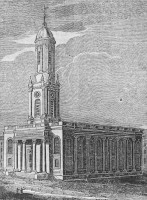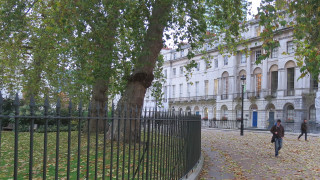
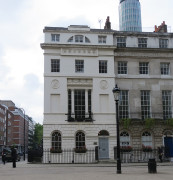 Fitzroy Square, Adam Brothers.
Fitzroy Square, Adam Brothers.
Just to the west of the top end of Tottenham Court Road, a little south of Euston Road, lies Fitzroy Square, of interest to these pages for one statue, just off the Square, a few bits of ornamental sculpture on the Robert Adam facades, and a history of residency by Victorian artists.
The Square is complete, with war damage repaired according to the original style. The East side went up first, from 1792-93, with the South side immediately afterwards in 1794, the architects for both being the Adam brothers. Although built as terraced houses, they aimed to make the whole of each side look like one large building, a novelty at the time. There was then something of a hiatus, and the Square was finished only in 1815, with the two later sides making some effort at harmony with the Adam frontages, though they had faced their buildings in Portland stone, while the later ones were stucco.
A large number of artists lived in the Square in the latter 19th Century – number 2 was inhabited successively by the painters William Dyce, a religious proto-Pre-Raphaelite, James Sant, the society portrait painter, T. F. Dicksee, and his more famous brother Frank Dicksee. More of the numerous artistic Dicksee family were at number 6, where also resided at one time and another John Pettie and William Quiller Orchardson, both big names in their time. At no. 7, rather forgotten today, lived Charles Lock Eastlake, President of the Royal Academy who, as was the custom at the time, also filled the role of Director of the National Gallery. Among various other artists, we shall mention only two – the Pre-Raphaelite fellow-traveller Ford Madox Brown (perhaps unfair as a description, as he came up with his own style before the PRB were on the scene), and at no. 40, a short residency by the ceramicist William de Morgan, before he settled in Chelsea. He lived there in the early 1860s, and it was there where he started the experiments in new types of glazes and lustres which were to bring him fame later on. Later on, members of the Bloomsbury Group inhabited the Square, which is associated with the formation of the group.
Roundels on the Adam Brothers facade to South side of Fitzroy Square.
The Adam Brothers’ architecture is as ever, impressive – four storeys high above a basement, something of a prominence to the centre of each side, and the corners, with Ionic pilasters higher up, etc. On the south side are four small roundels containing groups of figures, painted to the extent that little of the detail is now discernible, but with at least a sense of the compositions. On the entablature we may note a series of grim skulls of bulls are carved, a not infrequent decoration of the period. Such a carved cow or ox head is known as a 'bucranium', originally derived from ancient Roman buildings where bucrania recalled the sacrifice of oxen in temple rituals. They seem to have undergone something of a renaissance in 18th and early 19th Century buildings.
Carved cattle skulls (bucrania) as decoration.
The abstract sculpture by Naomi Blake in the Square is not within the scope of these pages, but just round the corner from the south-east, that is to say on the side of the south range towards Fitzroy Street, is a statue of General Francisco de Miranda, Venezuelan revolutionary and precursor to Simon Bolivar, with a note that he lived just round the corner at 58 Grafton Way from 1802-10. The work is a modern reproduction of a work by the Venezuelan sculptor Rafael de la Cova (1850-1896), whose best known work was a statue of Columbus, on a monument erected in Caracas between 1893-1904, and pulled down by indigenous protestors against the Venezuelan Government in 2004. The statue was mounted on an enormous base and short pillar, with three subsidiary figures, of which two survive.
General Francisco de Miranda, after Rafael de la Cova.
The Fitzroy Square figure is depicted standing, holding a scroll in one hand, the other on his chest. The style is flamboyant to the extreme, with the General wearing wide, ornamented lapels, a bow at his neck, a double row of buttons, and oversized boots with tassels. There is similarly grandoise South American work, of a much later date, in Belgrave Square.
Fitzroy Square is flanked to east and west by Fitzroy Street and Conway Street, with Cleveland Street next west of that, all running north to Euston Road, once New Road, and on these several streets lived many white-on-black monument makers in early 19th Century. It was a matter of taste who signed Fitzroy Square and who did not, and among those who did, noted on this website, were:
- M.W. Johnson, New Road, Fitzroy Square;
- Charles Regnart, Cleveland Street, Fitzroy Square;
- Sanders, New Road, Fitzroy Square;
- William Whitelaw, New Road, Fitzroy Square.
Another of the tribe, C.H. Smith, signed Clipstone Street, Fitzroy Square. The famous sculptor John Flaxman lived close to Fitzroy Square (on Greenwell Street off Cleveland Street), and Edward Davis, obscure now, also lived mostly in and around Fitzroy Square. For more on white-on-black monuments, see this page.
From Fitzroy Square, heading eastwards takes us to near the top end of Tottenham Court Road, or north and then west along Euston Road takes us immediately to Great Portland Street Station, opposite which is the former church of Holy Trinity, designed by John Soane. Though converted to other use, the exterior of this Classical building survives, with its round tower and dome and noble Ionic portico. Beyond to the west lies Portland Place.
John Soane's Holy Trinity, Euston Road.
